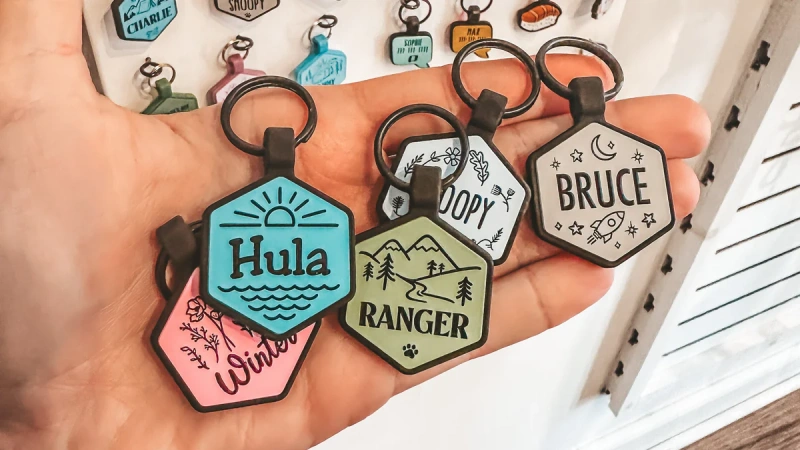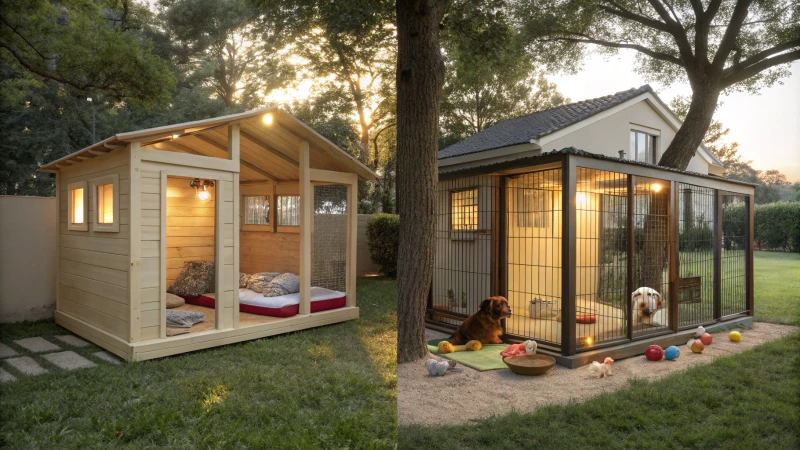
Ever wonder if your furry friend would prefer an indoor or outdoor kennel? The choice can make a world of difference in their daily life!
Indoor dog kennels are ideal for small spaces and harsh climates, offering protection from the elements, while outdoor kennels provide more space and natural exposure. Key setup elements include location, size, materials, ventilation, and safety tailored to each type.
I remember when I first debated whether to get an indoor or outdoor kennel for my dog. It felt like choosing between a cozy apartment and a sprawling countryside home. While both options aim to keep your pet safe and happy, understanding their differences can truly enhance your dog’s lifestyle.
For instance, indoor kennels work wonders in smaller homes or during colder months, providing a snug retreat for your pup. On the other hand, outdoor kennels are perfect for those sunny days when your dog craves more room to roam. I’ll guide you through setting them up to ensure you pick the best fit for your four-legged buddy’s needs.
Indoor kennels are better for small spaces.True
Indoor kennels fit small spaces and climates where outdoor living is hard.
Outdoor kennels require less maintenance than indoor ones.False
Outdoor kennels need regular cleaning and weatherproofing, unlike indoor ones.
How Do You Choose the Right Location for Your Dog Kennel?
Finding the perfect spot for your dog kennel can feel like a treasure hunt—but it’s worth the journey for your furry clients’ happiness. Let’s explore how to choose a location that keeps tails wagging.
To choose the right location for a dog kennel, think about zoning laws, accessibility, noise levels, and environmental conditions. It’s crucial to find a place that ensures both dogs’ comfort and owners’ convenience.
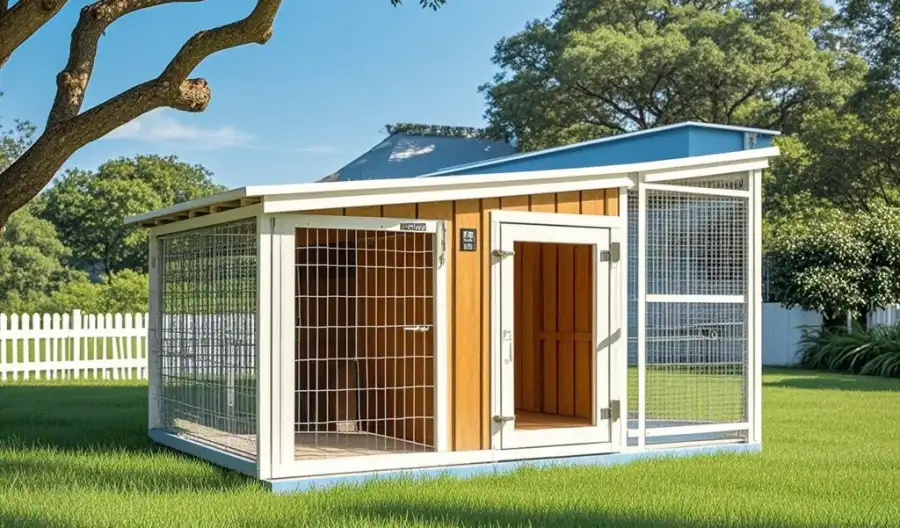
Zoning Laws and Regulations
I remember when I first started researching locations for my kennel; the maze of local zoning laws felt like trying to solve a Rubik’s cube. It’s essential to ensure your chosen spot is compliant, especially as some areas have strict rules about the number of dogs you can house or how close you can be to residential neighborhoods. Check the local zoning laws1 to ensure compliance.
Accessibility and Convenience
Think about the times you’ve driven to a store only to find it had limited parking or was buried in a hard-to-reach part of town. I wanted to make sure my kennel was easy to get to, with good road access and public transport options for those morning drop-offs and evening pick-ups. Ample parking was non-negotiable.
Noise Levels
Ah, the infamous noise! If you’ve ever visited a bustling kennel, you know they can be quite loud. I made sure to pick a location with natural sound barriers, like trees or hills, to keep the barking from becoming a neighborhood nuisance.
| Factor | Considerations |
|---|---|
| Zoning Laws | Compliance with local regulations |
| Accessibility | Proximity to roads and public transport |
| Noise Levels | Impact on neighbors; natural sound barriers |
Environmental Conditions
Selecting a site with great environmental conditions was like picking out a comfy bed—it had to be just right. I looked for spots with good drainage to prevent flooding and plenty of shade to protect our furry guests from the heat.
Safety and Security
Safety was always at the forefront of my mind. I avoided locations near busy roads or areas with wild animals. Fencing and surveillance systems were added bonuses that put my mind at ease.
Community and Surroundings
I also spent time getting a feel for how the community viewed kennels. A supportive neighborhood can be your biggest ally, while opposition could spell trouble down the line. Adding green spaces or play areas can enhance both the dogs’ experiences and your appeal to potential clients.
Consider integrating green spaces or play areas as this not only enhances the dogs’ experience but can also attract more customers who value their pets’ well-being.
Long-term Viability
I considered future development plans to ensure the location wouldn’t become less desirable over time. What’s peaceful today could be bustling tomorrow, and that could change everything.
Assessing long-term viability by considering future development plans ensures that what’s peaceful today doesn’t become bustling tomorrow, impacting operations negatively.
By keeping these factors in mind, I was able to find a location that was both welcoming for dogs and practical for their owners. It’s all about creating a space where everyone feels at home.
Zoning laws dictate kennel location options.True
Local zoning laws may limit where kennels can be established.
All kennel locations must be near public transport.False
Proximity to public transport is ideal but not mandatory for kennels.
What Materials Are Best for Indoor vs. Outdoor Dog Kennels?
Ever wondered what the perfect material for your dog’s kennel is?
For indoor dog kennels, I recommend using durable materials like wood or sturdy plastic because they can handle the usual wear and tear. On the other hand, outdoor kennels thrive on weather-resistant materials like galvanized steel or treated wood to withstand the elements.
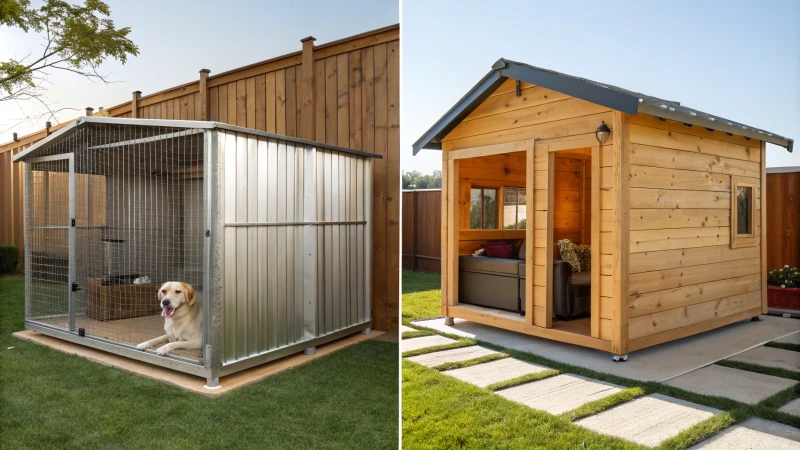
Indoor Dog Kennel Materials
I’ve spent countless hours figuring out how to make my dog’s indoor kennel both cozy and durable. After some trial and error, I’ve settled on materials like wood2 and sturdy plastic. These materials not only handle the rough play but are also easy to clean, which is a lifesaver when you’re juggling multiple responsibilities. Plus, by adding ventilated panels made of mesh3, I found it really helps keep the air fresh inside, so those lingering doggy odors are less of a problem.
| Material | Benefits | Considerations |
|---|---|---|
| Wood | Durable, natural aesthetic | Requires maintenance |
| Sturdy Plastic | Lightweight, easy to clean | Can warp over time |
Outdoor Dog Kennel Materials
When it comes to setting up an outdoor kennel, choosing the right materials was even more crucial for me due to our unpredictable weather. I went with galvanized steel4, and I can’t emphasize enough how sturdy and rust-resistant it is. It’s been through rain and shine without a hitch. Treated wood is another great option I considered; it blends perfectly with the backyard and keeps the kennel insulated during our chilly Canadian winters.
It’s also smart to think about water damage. I added elevated flooring to my setup, which keeps everything dry and my pup comfy no matter how much it rains.
| Material | Benefits | Considerations |
|---|---|---|
| Galvanized Steel | Weather-resistant, strong | Can be heavy |
| Treated Wood | Insulating, aesthetic appeal | Requires regular sealing |
For both indoor and outdoor kennels, I’ve learned that adding comfort features like removable bedding5 is essential. It makes cleaning so much easier, and extra insulation can really help with temperature control. Regularly checking on these materials ensures they stay safe and durable—something that’s become a bit of a routine for me now.
Wood is ideal for indoor dog kennels.True
Wood provides durability and a natural aesthetic, suitable for indoors.
Galvanized steel is unsuitable for outdoor kennels.False
Galvanized steel is weather-resistant and strong, ideal for outdoors.
How Can You Ensure Proper Ventilation in Dog Kennels?
Ever walked into a dog kennel and felt like you’re in a sauna or a smelly locker room? That’s why proper ventilation is key.
To ensure proper ventilation in dog kennels, focus on strategic placement for natural airflow, use breathable materials like mesh, and consider mechanical systems like fans or HVAC for better air circulation. A mix of these strategies can help maintain a comfortable and healthy environment for your dogs.

Understanding the Importance of Kennel Ventilation
Imagine stepping into a room that feels stuffy and uninviting—now think about how your furry friends might feel in a poorly ventilated kennel. It’s not just about comfort; it’s about health. I remember setting up my first kennel and realizing that without proper airflow, my dogs seemed restless and unhealthy. Good ventilation is essential for maintaining air quality and preventing moisture and pathogens from building up, which can lead to respiratory issues. Ensuring sufficient air circulation6 helps maintain an optimal environment.
Effective Strategies for Kennel Ventilation
-
Placement: My first tip is to choose locations with natural breezes. Avoid placing kennels in corners or enclosed spaces where air might become stagnant. The first time I moved my kennels closer to a naturally breezy spot, I noticed an immediate improvement in my dogs’ energy levels.
-
Materials: Opt for breathable materials like mesh or perforated panels. This allows free airflow, making a world of difference. When I switched to mesh panels, it felt like opening a window in a stuffy room.
-
Systems: Consider installing fans or HVAC systems to optimize airflow. It’s like giving your kennel its own little climate control. Make sure to adjust these systems seasonally for better efficiency.
Table: Comparison of Ventilation Methods
| Method | Advantages | Considerations |
|---|---|---|
| Natural | Energy-efficient, cost-effective | Dependent on weather conditions |
| Mechanical | Consistent airflow, adjustable | Initial cost, ongoing maintenance |
| Hybrid | Combines natural and mechanical | Requires careful planning |
Implementing Natural Ventilation
Natural ventilation is like the unsung hero of kennel design. It involves strategic openings that create cross-breezes—think of it as letting nature do some of the work for you. It’s energy-efficient but during extreme weather, you might need a backup plan. Elevating the kennel slightly can allow air to circulate from underneath, which worked wonders for me.
Using Mechanical Ventilation Systems
Mechanical systems such as fans and air conditioning units offer control over the climate within the kennel. They’re particularly useful in extreme temperatures. Regular maintenance is key here—I learned this the hard way when one of my systems broke down during a heatwave.
Combining Methods for Optimal Results
In my experience, a hybrid approach often yields the best results. Combining mesh panels with strategically placed fans ensures consistent airflow even on still days. I suggest designing kennels7 with flexibility in mind, allowing you to adapt as needed. By regularly monitoring conditions and adjusting systems accordingly, you’ll ensure your kennel remains a comfortable haven for dogs year-round.
Natural ventilation is weather-dependent.True
Natural ventilation relies on outdoor conditions, which can vary.
Mesh panels block airflow in kennels.False
Mesh panels allow air to flow freely, aiding ventilation.
What Safety Features Should You Consider for Dog Kennels?
Choosing the right dog kennel safety features feels a lot like setting up a cozy, secure nest for your beloved pet. Here’s how to ensure your furry friend stays safe and comfy.
To keep your dog safe in their kennel, ensure it’s the right size, made from durable materials, and has secure locks and good ventilation. Regular inspections and comfy bedding also play a key role in their well-being.
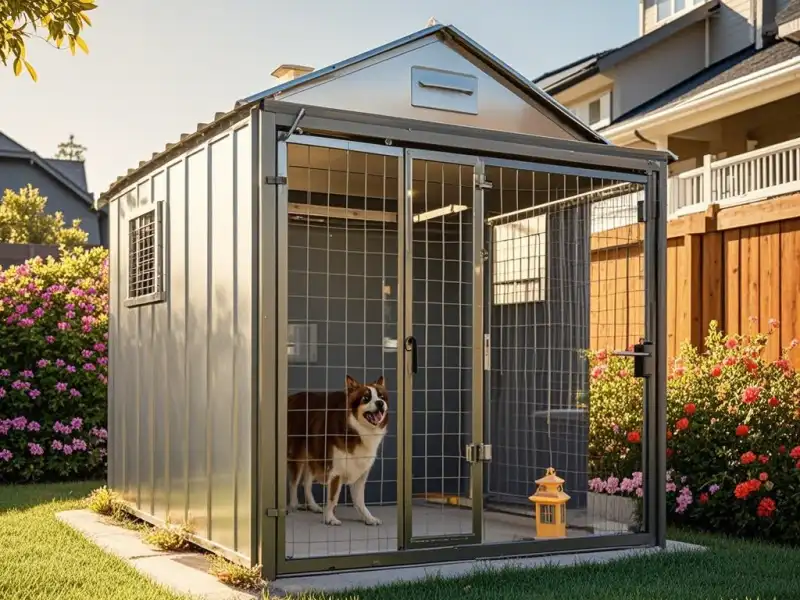
Ensuring Proper Kennel Size
I remember the first time I set up a kennel for my own pup—it felt like such a big responsibility to get it just right. A kennel needs to be more than just a cage; it’s your dog’s private sanctuary. You want it to be spacious enough so they can stand, turn around, and stretch out comfortably. I always measure from my dog’s nose to tail and add a few inches to make sure there’s plenty of wiggle room.
| Dog Size | Recommended Kennel Dimensions |
|---|---|
| Small Breeds | 24" L x 18" W x 21" H |
| Medium Breeds | 30" L x 22" W x 24" H |
| Large Breeds | 36" L x 24" W x 26" H |
Choosing Durable Materials
When I was choosing a kennel, durability was key. I wanted materials like sturdy plastic8 or wood that could stand up to my dog’s playful antics without any risk of breaking or causing harm. Plus, sharp edges were a no-go—I wanted peace of mind knowing my dog couldn’t get hurt while I wasn’t looking.
Implementing Secure Locking Mechanisms
Having a secure lock is vital. I learned this the hard way when my dog managed to nudge open a less-than-secure latch and had a grand old time running around the house. Now, I ensure the locks are not only secure but also easy for me to operate while being tricky for my clever canine escape artist. Consider backup options like double locks9 for added security.
Maintaining Good Ventilation
A kennel needs good airflow to prevent any unpleasant odors and to keep things fresh. I always look for kennels with mesh panels or air vents to help with ventilation. It’s such a relief to know that this also helps prevent any potential respiratory issues for my dog.
Ensuring Comfort with Bedding
Comfy bedding is an absolute must. I once made the mistake of skimping on this, and let’s just say my dog wasn’t impressed. Now, I always include soft bedding or mats that offer warmth during colder months and are easy to clean.
Regular Inspections and Maintenance
Finally, regular checks are non-negotiable. I make it a habit to inspect for any sharp edges or protruding parts that might harm my dog. Keeping an eye on the locks and ventilation systems also ensures ongoing safety.
By focusing on these features, I’ve found that my dog’s kennel becomes a safe haven rather than just a place to stay. It’s about more than safety—it’s about creating a comfortable, secure environment where your pet can thrive.
For those looking to dive deeper into kennel care, exploring resources on kennel maintenance tips10 can be incredibly helpful.
Kennel size affects a dog's stress levels.True
A kennel too small can cause stress and health issues for dogs.
All kennels should have double locks.False
While secure locks are important, not all require double locks.
How Can Comfort Be Enhanced in Dog Kennels?
I remember the first time I left my dog at a kennel; I was a nervous wreck, hoping he’d feel at home. Creating a cozy space for our furry pals is a mission worth every wag and woof.
Enhancing comfort in dog kennels involves creating ample space, adding soft bedding, ensuring proper ventilation, and providing engaging activities. Including familiar items and calming scents can also help reduce stress and make the environment more comforting for dogs.
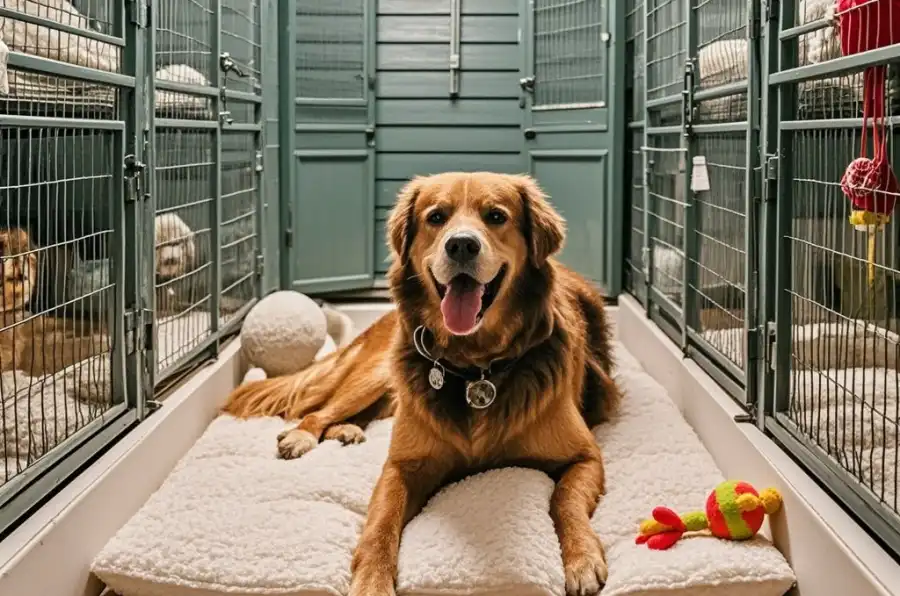
The Importance of Space
Reflecting on my experience, I realized how crucial it is for kennels to offer enough space for dogs to move freely. I made sure my dog had enough room to stand, turn around, and lie down comfortably. To figure out the right size, I measured him from nose to tail and added a few inches for that extra wiggle room. For larger breeds, I looked for enclosures where they could stretch out without feeling cramped.
| Dog Size | Recommended Kennel Size |
|---|---|
| Small | 24" x 18" x 21" |
| Medium | 30" x 21" x 24" |
| Large | 36" x 24" x 27" |
| Extra-Large | 48" x 30" x 33" |
Creating a Cozy Environment
When it comes to bedding, I’ve learned through trial and error that soft, easy-to-clean materials make all the difference. Orthopedic beds have been lifesavers for my older dog, offering much-needed support. Bringing along his favorite blanket or toy adds a touch of home that eases his anxiety. Incorporating familiar items11 can help ease anxiety.
Ventilation and Temperature Control
Proper ventilation is key to keeping the air fresh and breathable. I always check for kennels with mesh panels or air vents. It’s important to place the kennel away from direct sunlight or drafts to avoid temperature extremes, which can be uncomfortable for our pets.
Engagement and Stimulation
I’ve found that boredom can lead to stress in dogs. That’s why I include interactive toys12 or puzzle feeders to keep them mentally stimulated. Regularly rotating these toys keeps their interest piqued.
Calming Aids and Scents
Aromatherapy has been a game-changer for us. Using dog-safe essential oils like lavender or chamomile creates a serene atmosphere. Placing a diffuser outside the kennel helps disperse these calming scents gently.
Safety and Security
One of my top priorities is ensuring the kennel is free of hazards like sharp edges or loose parts. A secure locking mechanism is essential for safety but should still be easy to operate in emergencies.
For outdoor settings, I ensure the fencing is at least 6 feet high to prevent any escape attempts. Providing shade is equally important to shield them from sun exposure. Implementing these safety measures13 helps create a comfortable and secure environment for our beloved companions.
Dogs need enough space to move freely in kennels.True
Sufficient space allows dogs to stand, turn, and lie comfortably.
Familiar items in kennels increase dogs' anxiety.False
Familiar items help ease dogs' anxiety by providing comfort.
Conclusion
Indoor and outdoor dog kennels differ in space, materials, and ventilation needs. Proper setup ensures comfort and safety for pets, enhancing their overall well-being.
-
Understanding local zoning laws helps ensure your dog kennel is compliant and legally operated. ↩
-
Discover why these materials are recommended for indoor kennels and how they contribute to your pet’s comfort and safety. ↩
-
Learn about various ventilation solutions that can enhance airflow and maintain freshness in indoor kennels. ↩
-
Understand the advantages of using galvanized steel in outdoor settings and its impact on durability. ↩
-
Explore options for removable bedding that can improve cleanliness and comfort in dog kennels. ↩
-
Explore how to enhance kennel air circulation with practical tips for ensuring better airflow, essential for maintaining healthy conditions. ↩
-
Learn about innovative kennel designs that optimize ventilation, offering insights into creating healthier environments for dogs. ↩
-
Explore durable materials suitable for dog kennels to ensure longevity and safety. ↩
-
Learn about secure locking systems to prevent accidental escapes from kennels. ↩
-
Understand the importance of regular inspections to maintain kennel safety and functionality. ↩
-
Using familiar items like blankets or toys can reduce anxiety and create a sense of security for dogs. ↩
-
Interactive toys engage dogs mentally and physically, helping prevent boredom and reduce stress during their stay. ↩
-
Ensuring proper fencing and environmental conditions is crucial for safety and comfort in outdoor kennels. ↩


